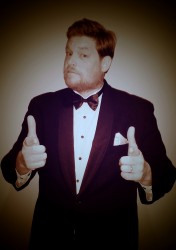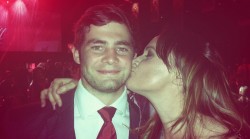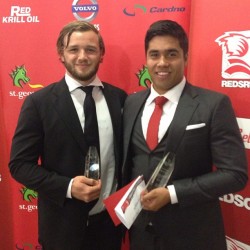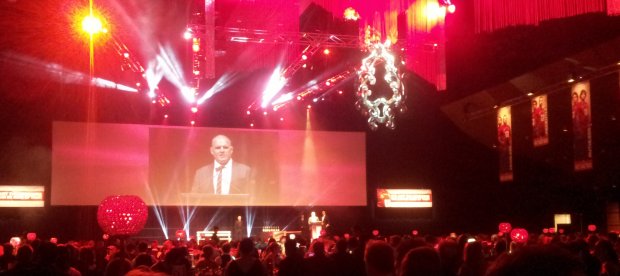
Let me set the scene a little…
There was plenty of glitz and glamour (and that was just me) as Queensland rugby came together to celebrate the season, farewell Ewen McKenzie and announce the inaugural QRU Hall of Fame inductees. The house lights dim and a spotlight hits the main stage, a strong and handsome looking fellow stands there, demonstrates his favourite party trick of opening a beer with his wedding ring, takes a fair swig and begins:
Hello ladies and gentleman, boys and girls my name is Steve “Mr” Timms and I’ll be your host tonight, we come together for Queensland rugby’s night of nights in what is their 130th year. While I would like to spend some time telling amusing anecdotes about my playing days, I won’t waste time in what is already a bumper schedule.

The first award for the night is People’s Choice, and a big congratulations goes to Liam Gill. The People’s Choice Award is voted by the fans and awarded to the player Reds supporters deem to have made the biggest individual impact in the 2013 season. So congratulations goes to Liam.
Moving on to the Alec Evans medal, which is awarded to the Queensland Premier Rugby Player of the Year and is voted on by referees. The nominees this year are: Matt Brandon and Jack Mullin from East’s, Samuela Kerevi of GPS, Sam Green and Brett Gillespie of Wests. And the winner is, Brett Gillespie of Wests.
Moving right along, we have an award that is close to my heart, Most Improved. I, like most elite rugby players, am always trying to improve, so this award goes to the player who has made the most gains through 2013. So, without further ado, the winner is Jake Shatz. Shatzy has gone from strength to strength this year, becoming a regular starter, forming a vital cog in what has been a very well balanced back-row and most recently being awarded by being included in the national Squad, nice work Jake. We’d grab a word with Jake, but I have a feeling we might be hearing a little more from him later.

The next award is the Rookie of the year award, given to the player deemed the best debutant of the year, this year it goes to Curtis Browning. Curtis had an impressive breakout season that included captaining the Australian team at the Junior world cup this year. It was against the Bulls at Suncorp Stadium, where Curtis contributed to the Reds 23-18 win that he made his Reds debut. That’s an impressive set of a achievements but rumour has it the pinnacle is yet to come with an appearance on the critically acclaimed GAGR Podcast on the cards soon.
Our next award is The Spirit of the Reds award. This award goes to the player who best displays the characteristics which embody the culture of the Reds. This years recipient goes to a star of the future in Jarrad Butler. With Red’s Head Coach Richard Graham overheard saying ‘Jarrad has progressed through from school and club Rugby into the Reds Squad. He has also done a lot of work off the field this year in the community helping other areas of the business grow and develop.’
Now for the big one. The Pilecki Medal is the players player award and is voted on a 3-2-1 basis by the players following each game of the season. 2013 has seen a return to sanity, with the forwards making up the bulk of votes. Let’s get down to the votes, coming in at 5th with 125 points and the only back in the top 5, Will Genia. 4th and polling 206 votes is Greg Holmes. Last years winner James Slipper had a good crack at it but ultimately fell short with 227 votes. With 262 votes, People’s Choice winner Liam Gill was agonisingly close to the eventual winners 269 points. Winning it this year was Jake Schatz, only the second #8 to get the gong. Congratulation Jake. Let’s hear from Jake and Stan now…
[youtube id=”wIg1_HJyLQw” width=”600″ height=”350″]
Well, I know you will agree that it has been an amazing night so far. We have one last presentation to make, tonight we get to institute a marvellous tradition in QLD rugby, with the creation of a Hall of Fame for QLD players and coaches. The selection criteria for inductees into the Hall of Fame are: they must have been retired from Queensland for ten years, they have played and/or coached for Queensland, and they have made an overall contribution to the game. Tonight we get to open the Hall, with the first 11 players to be inducted, the Inaugural Queensland Rugby Union Hall of Fame Inductees are;
Arthur Hickson
A pioneer of the Northern Rugby Union, later the Queensland Rugby Union, Arthur Hickson was Captain of the first Queensland team in 1882 and captained his state in every game against NSW until 1886.
A strong and stout man, Hickson was born in Ireland and was a lawyer by profession. His leadership was in the face of constant challenge not only from NSW sides, but other football codes. This gave Queensland Rugby the platform upon which its proud 130 year record has been built.
Phil Carmichael
Queensland and Australian Rugby’s first match-winning goal-kicker, Phil Carmichael represented Queensland and Australia with distinction at fullback in the early years of last Century. Regarded as one of his generation’s greatest Rugby players, Carmichael’s goal-kicking helped establish an international reputation for Australia.
Carmichael first represented Queensland at the age of 20 in 1903, and continued on until he was 26, playing 28 games for the State and captaining the side on five occasions.
Debuting for Australia in 1904 against the touring British team, Carmichael enjoyed a very successful international Rugby career. In the first Wallaby tour in 1908, which included a Gold Medal at the London Olympics, Carmichael headed the scoring with 118 points from goals.
A sure tackler and an excellent handler, who specialised in the high punt ahead, Carmichael won premierships at club level with Valleys. He was voted “Brisbane’s Most Popular Player” and was a forerunner to the Rothmans and Evans medals, upon retirement.
Jimmy Flynn
Jimmy Flynn was a state and national representative centre and half-back who began his Rugby career for Queensland in 1912, at the age of 17. He was selected to represent the State after making a big impression for his club team in the Brisbane First Grade Rugby competition.
His potential at such a young age excited selectors and Flynn was selected in the Wallabies squad for the 1912 Australian Rugby Union tour of Canada and the USA.
His Test debut was made in 1914 when he played in both fixtures against the touring All Blacks. In the second Test on 1 August, 1914 he had the honour of captaining the Wallaby side becoming Australia’s youngest Rugby captain at 20 years of age. His record still stands as the youngest man to do so.
The Great War interrupted Flynn’s career as rugby in Australia effectively ceased at that time. Although Rugby was in a state of demise in Queensland until 1929, Flynn had a hand in its rebirth as a Queensland and national selector in 1929 and 1930.
Tom Lawton Senior
Tom Lawton Snr enjoyed a decorated playing career captaining Queensland, New South Wales and Australia over the space of 12 years. He was the first of three members of the Lawton family to represent the both state and country in Rugby, with grandsons Tom and Rob also completing the feat.
Lawton Snr was an influential figure in leading the renaissance of Queensland and Australian Rugby after World War I, where he served in The Great War with distinction. Following his impeccable service, he completed his medical studies at the University of Queensland, and as a Rhodes Scholar at Oxford.
During this period his sporting abilities flourished as he represented Oxford in athletics, swimming and water polo, also earning selection for the Barbarians during his sojourn in Britain.
Upon his return, Lawton Snr led the first Queensland sides after its revival in 1928, and immediately took his place in the Wallabies again, leading Australia to a historic 3-0 whitewash of the All Blacks in 1929.
Eddie Bonis
Eddie Bonis played a major role in the revival of the Queensland Rugby Union in 1929 after a 15-year recess following World War I.
He played his entire representative Rugby career as a hooker, appearing in 43 inter-State matches and 21 Tests.
His value to Australian teams was most apparent on long tours, when his strength and enthusiasm remained unabated for weeks on end.
Bonis’ Rugby career for Queensland lasted 16 years after he made his debut in 1929. The peak of his career was when he led Queensland to a 19-14 win against NSW in the first inter-State match after World War II, scoring a try.
Des Connor
One of the finest halfbacks to play for Australia, Des Connor made important contributions to Australian Rugby as a player, coach and selector. Ranking high among the game’s strategists, he provided all countries with an interesting innovation when he invented the short lineout.
Tipped to become an international while still at school at Marist College Ashgrove, Connor debuted for Queensland in 1954 and became a regular in the side until 1959, when he moved to New Zealand. Des Connor first represented Australia in 1958 on the Wallaby tour of Britain and France, before going on to earn a total of 24 international caps for both Australia and New Zealand.
Connor played for Australia against the British Lions in 1959, before moving to New Zealand to accept a job at Auckland’s Takapuna Grammar School. He then played for the All Blacks from 1961 to 1965, earning the unique honour of captaining both the Wallabies and All Blacks.
On his return to Australia in 1967, Connor coached his old Brisbane club, Brothers, to a premiership before being appointed Australian coach in 1968 for the tests against New Zealand.
To combat the dominant New Zealand forwards, Connor innovated with the short line-out, a tactic that is now commonplace in International Rugby.
Mark Loane
Mark Loane was the messianic leader of Queensland Rugby’s revival in the 1970’s, as he captained a Queensland side that rose to the top of provincial Rugby, and then led a Wallabies side that captured the Bledisloe Cup for the first time in 40 years.
Under his leadership both Queensland and Australia increased their standing within the sport, his efforts on a personal level were also recognised by selection in numerous World XV’s throughout his career. He played for Natal in 1980, and was selected in the South African Barbarians and Junior Springboks sides, before turning his back on the opportunity to play for the Springboks to return and captain Queensland in the 1982 Centenary Year, as well as to finish his Wallaby career in the same year.
His talent and electric personality saw Loane be described as a “folk hero to the Ballymore faithful”, during one of the more decorated playing careers enjoyed by a Queensland sportsperson.
Loane’s abilities stretched far beyond the field of play, as he is an ophthalmic surgeon. In 2011, Loane was made a Member of the Order of Australia for his service to medicine in the field of ophthalmology, particularly to the indigenous communities of Northern Queensland and as a contributor to the development of sustainable health services throughout the country.
Paul McLean
Paul McLean was arguably one of Australian Rugby’s greatest point scorers. He is a player who is revered in Queensland as much for his gentle, almost poetic manner as for his achievements.
His talent helped turn Rugby in Queensland from a minor sport to one of the State’s major crowd-pullers. McLean joined the Queensland team in 1973, and along with players such as Mark Loane and Tony Shaw, Queensland started beating NSW by unprecedented margins, recording scores such as 42-4 and 48-10.
With McLean directing play, Queensland also defeated an impressive list of touring teams, including the mighty All Blacks in 1980 and Scotland in 1982.
McLean scored exactly 1000 points for Queensland, reaching this amazing mark in his 100th and final match for the State in the last game of 1982, Queensland’s centenary year.
McLean began his Test career with 16 points from three games against New Zealand in 1974 and ended with the 1982 test against Scotland where he scored a total of 21 points from penalty goals and conversions.
Michael Lynagh
Michael Lynagh debuted for Queensland in 1982, immediately after leaving school and before playing first grade in Brisbane. After reaching these career highs he then went on to score 1166 points for Queensland in 100 games for his State.
Lynagh made his debut for Australia against Fiji in Suva in 1984, aged 20. Early in his career he played at inside centre however when Mark Ella retired Lynagh took over as the Australian fly-half. He was the on-field leader for the Golden Era of Queensland and Australian teams in the early 1990s.
Retiring at the advent of professionalism from a glittering 12-year international career with Queensland and Australia, Lynagh finished his career as the world record Test points scorer with 911 points, with successes such as the 1984 Grand Slam, Bledisloe Cups, and 1991 Rugby World Cup win, along with Super 6 and Super 10 wins with Queensland.
Whenever Rugby’s greatest fly halves and goal kickers are mentioned, the name Michael Lynagh is always one of the first spoken.
Tim Horan
Horan won 119 caps for Queensland, 80 caps for Australia and scored 30 international tries in a glittering 11-year career that included two Rugby World Cup victories in 1991 and 1999.
He formed memorable partnerships with Jason Little and later Daniel Herbert for both Queensland and Australia and with his superb all-round game carved out a reputation as one of the greatest centres to have played the game.
He made his international debut against New Zealand in 1989 before debuting for Queensland in 1990 against Western Samoa. Horan was an integral part of the 1991 Rugby World Cup winning team where he scored four tries as the Wallabies secured the game’s biggest prize for the first time.
He battled back from a career threatening knee injury in 1994 to make his second Rugby World Cup appearance in 1995. But it was at the 1999 event that he arguably reached his peak, including an unforgettable battle against illness and the Springboks in the semi-final. His stand-out performances saw him named the Player of the Tournament.
He remains a servant to Queensland Rugby through his off field work with players and media duties.
John Eales
John Eales is an iconic Queensland and Australian Rugby player and respected administrator, lauded for his services to the sport as a fine captain and later as an Australian Rugby Union Board Member.
In 1999, Eales was made a Member of the Order of Australia (AM) for his contribution to Rugby and in the community after a decorated career which included success for the Queensland Reds in winning the 1992 Super Six, then 1994 and 1995 Super 10 competitions. He played for Australia on 86 occasions, 55 as captain, winning the Rugby World Cup in 1991, and as captain in 1999.
Regarded as one of Queensland and Australia’s finest ever players and second-rowers, Eales proudly represented Queensland from 1990-2001 and the Wallabies from 1991-2001, captaining Australia from 1996 onwards. He retired by leading the Wallabies to the Bledisloe Cup in 2001, having just led the country to its first win against the British and Irish Lions (2-1).
Upon retirement, Eales had guided the Wallabies to every available piece of silverware Australia could win in the international arena, and in his post-playing career used his leadership abilities and knowledge as a delegate to several national and international sporting committees while also being involved in numerous charitable ventures.
[youtube id=”7BY44RCLRH4″ width=”600″ height=”350″]
n.b. Because a bunch of these players were before my time, I have started by copying the QRU press release, that worked so well, I just did it for all the players (efficient, not lazy!)

